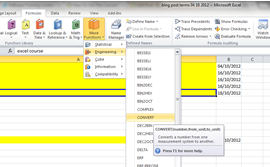Converting dates and times
Dates and times often require converting and Excel can do this for you automatically, you just need to set it up, to do so.
For example, if you add or subtract calculations between two dates, Excel will automatically give the result in days unless you tell it otherwise. So you need to perform another calculation to get the result in the format you require (years, months or hours).
For example, a call centre keeps a worksheet with the start and end times and dates for calls received. The manager wants to find out how long each call takes. To show the duration in the most appropriate unit, the answer needs to be presented in minutes rather than hours, however, the format of the data means that the result is shown in days. So the manager can use the following convert formula to show the results in minutes instead:
=CONVERT(G5,”day”,”hr”)
Converting weights
An example would be converting ounces to grams in sales data for a family butcher, and he uses the the following formula:
=CONVERT(A1,”ozm”,”g”)
Length conversion
An online fabric shop may need imperial and metric measures for selling material. In the UK, many people still ask for a yard of fabric rather than a metre, and data can be stored on a stock spreadsheet easily in both units. This way those people who think in yards can see the yards, those who want metres can see metres. The following formula would achieve this:
=CONVERT(G5,”m”,”yd”)
There are more units that you can convert. To explore this function and get more out of Formulas consider attending one of our Excel courses. Find out more on https://www.stl-training.co.uk/excel-2010-intermediate.php
